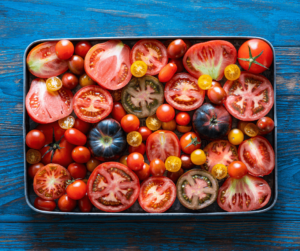Are tomatoes bad for arthritis? Fresh, frozen, canned or concentrated tomatoes aren’t necessarily bad for arthritis. In fact, in many cases, they are the opposite.
Classified as a fruit but called a vegetable for nutritional and cooking purposes, tomatoes are loaded with health-promoting compounds. Antioxidants, phenolics, vitamin C, lycopene and β-carotene in tomatoes prevent chronic diseases such as cancer and heart disease. They make up a decent part of our nutritional intake here in Aotearoa across many cultures and ages.

A 2019 study from Auckland University of Technology suggests that 8 out of 10 New Zealand adults are at moderate or higher risk of adverse health outcomes related to not eating enough veggies. Be wary of information vilifying fruit or vegetables, and make sure you do a fact check with a health or nutrition professional. You don’t want to remove tomatoes from your diet, or any vegetable, if you don’t have to! Although the cost of fresh tomatoes in New Zealand may mean that they have disappeared from your diet, canned tomatoes still provide a nutritious, budget-friendly option. Tomato is one vegetable that increases in nutrition when it is cooked.
Arthritis
There is no robust medical evidence that tomatoes cause an arthritis flare or worsen symptoms. Although some people have noted that tomatoes worsen their arthritis symptoms, currently, this is anecdotal evidence only. Tomatoes are part of the Mediterranean eating pattern, associated with lower inflammation than a standard western diet and overall better health. Lycopene, one of the key compounds in tomatoes, is a well-established antioxidant with promising anti-inflammatory action.
Gout Arthritis
To try to find a reason for so many accounts of tomatoes causing gout flares, Otago University did some research in 2015. It linked higher tomato consumption with more elevated serum uric acid levels. This provides the basis for a theory that tomato consumption may be a factor in serum uric acid levels and gout attacks for people with gout. Before we can conclude, more studies must be done to find a direct cause between tomato consumption, serum uric acid levels and gout attacks. Gout arthritis is managed first and foremost with medicine. Once someone diagnosed with gout takes medication, they can usually eat their regular diet, including “trigger” foods in small to moderate amounts.
Intolerance or allergy?
Allergies to tomatoes are rare; more people are intolerant or sensitive to tomatoes if they react. Symptoms may vary from person to person but can include diarrhoea, wind, abdominal pain, bloating, or triggering of arthritis symptoms. If you think you have a sensitivity to tomatoes, test it. Remove them from your diet for two weeks, then introduce them back into your diet slowly in increasing amounts. You may find that you can tolerate a small amount, but higher amounts might cause some issues. If you find that eating tomatoes or certain tomato products cause symptoms, then don’t eat them.
Papaya and watermelon are good sources of lycopene that you may wish to include in your diet more often if you remove tomatoes permanently.
Where did the rumour start?
Tomatoes have an exciting history from their origins in South America, who have been eating tomatoes since around 700AD. When people brought seeds to Europe at the beginning of the 16th century, the rumours began that they were poisonous plants. Germany and England initially grew tomatoes because they looked pretty.
The reason for the distrust began when botanists classified tomatoes in the same family, Solanum, as the well-known, poisonous belladonna, aka deadly nightshade. The second part of the scientific name for the garden tomato, lycopersicon, translates from Greek to “wolf peach”, which added to the fears in Europe.
Tomatoes were mistaken as one of the poisonous members of the Solanaceae family. Once a rumour starts, we all know how quickly it can spread and how difficult it is for the truth to be accepted. The fact that people in South America ate tomatoes and were fine did not convince Europeans and North Americans that they weren’t poisonous.
Like all members of the Solanaceae family, Tomatoes contain glycoalkaloids which protect the plants from fungi, insects and bacteria. Different members of the Solanaceae family have different types and amounts of glycoalkaloids. Some, like deadly nightshade, are poisonous to animals and humans. The tomato plant’s major glycoalkaloid, α-tomatine, has not been proven poisonous to animals or humans. The leaves and stems of the tomato plant have the highest concentration of tomatine, and the ripe fruit has undetectable to very low levels. Some chefs and home cooks use dried tomato leaves, even with higher amounts of tomatine, to flavour dishes without concerns. It took some time for Europeans and those in North America to watch people they knew eat tomatoes and survive before the rumour was dispelled.
Bottom line
If tomatoes aren’t a personal trigger for your arthritis symptoms, keep them in your diet! They are full of nutritional benefits and easy to access in New Zealand in various fresh and minimally processed products.
For more information about food allergies Eating Safely when you have Food Allergies (mpi.govt.nz)